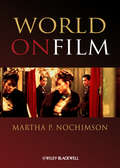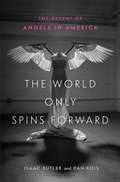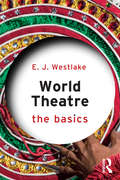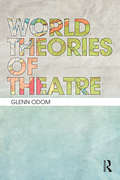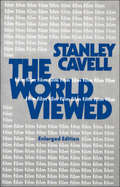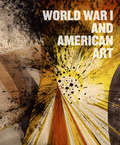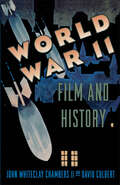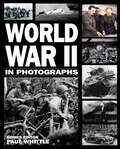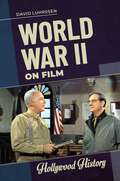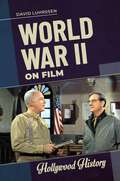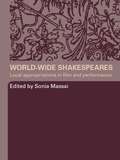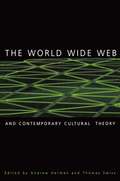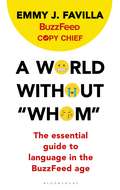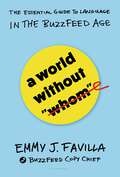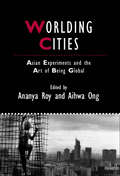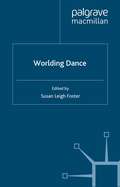- Table View
- List View
World on Film: An Introduction
by Martha P. NochimsonThis uniquely engaging and lively textbook provides a comprehensive introduction to international film, from the golden age of European cinema to the contemporary blockbusters of India and Asia, and the post World War II emergence of global film culture. Offers an overview of film culture in European countries such as France, Sweden and Spain, as well as Africa, Hong Kong, China, and India, in a clear and conversational style to engage the student reader Provides a detailed exploration of the impact of globalization on international cinema Includes a comprehensive companion website (www.wiley.com/go/worldonfilm) with an expansive gallery of film stills also found in the text, plus access to sample syllabi for faculty and a detailed FAQ Addresses the differences in visual and narrative strategies between Hollywood-influenced movies and international cinema Highlights key words within the text and provides a comprehensive glossary of critical vocabulary for film studies Each chapter includes in-depth case studies of individual films and directors, cultural and historical context, selected filmographies, and ideas for projects, essays, and further research
The World Only Spins Forward: The Ascent of Angels in America
by Isaac Butler Dan KoisThe oral history of Angels in America, as told by the artists who created it and the audiences forever changed by it--a moving account of the AIDS era, essential queer history, and an exuberant backstage tale.When Tony Kushner's Angels in America hit Broadway in 1993, it won the Pulitzer Prize, swept the Tonys, launched a score of major careers, and changed the way gay lives were represented in popular culture. Mike Nichols's 2003 HBO adaptation starring Meryl Streep, Al Pacino, and Mary-Louise Parker was itself a tour de force, winning Golden Globes and eleven Emmys, and introducing the play to an even wider public. This generation-defining classic continues to shock, move, and inspire viewers worldwide. Now, on the 25th anniversary of that Broadway premiere, Isaac Butler and Dan Kois offer the definitive account of Angels in America in the most fitting way possible: through oral history, the vibrant conversation and debate of actors (including Streep, Parker, Nathan Lane, and Jeffrey Wright), directors, producers, crew, and Kushner himself. Their intimate storytelling reveals the on- and offstage turmoil of the play's birth--a hard-won miracle beset by artistic roadblocks, technical disasters, and disputes both legal and creative. And historians and critics help to situate the play in the arc of American culture, from the staunch activism of the AIDS crisis through civil rights triumphs to our current era, whose politics are a dark echo of the Reagan '80s.Expanded from a popular Slate cover story and built from nearly 250 interviews, The World Only Spins Forward is both a rollicking theater saga and an uplifting testament to one of the great works of American art of the past century, from its gritty San Francisco premiere to its starry, much-anticipated Broadway revival in 2018.
World Theatre: The Basics (The Basics)
by E. J. WestlakeWorld Theatre: The Basics presents a well-rounded introduction to non-Western theatre, exploring the history and current practice of theatrical traditions in Asia, Africa, the Middle East, Oceania, the Caribbean, and the non-English-speaking cultures of the Americas. Featuring a selection of case studies and examples from each region, it helps the reader to understand the key issues surrounding world theatre scholarship and global, postcolonial, and transnational performance practices. An essential read for anyone seeking to learn more about world theatre, World Theatre: The Basics provides a clear, accessible roadmap for approaching non-Western theatre.
World Theatre: The Basics (The Basics)
by E. J. WestlakeWorld Theatre: The Basics presents a well-rounded introduction to non-Western theatre, exploring the history and current practice of theatrical traditions in Asia, Africa, the Middle East, Oceania, the Caribbean, and the non-English-speaking cultures of the Americas. Featuring a selection of case studies and examples from each region, it helps the reader to understand the key issues surrounding world theatre scholarship and global, postcolonial, and transnational performance practices. An essential read for anyone seeking to learn more about world theatre, World Theatre: The Basics provides a clear, accessible roadmap for approaching non-Western theatre.
World Theories of Theatre
by Glenn A. OdomWorld Theories of Theatre expands the horizons of theatrical theory beyond the West, providing the tools essential for a truly global approach to theatre. Identifying major debates in theatrical theory from around the world, combining discussions of the key theoretical questions facing theatre studies with extended excerpts from primary materials, specific primary materials, case studies and coverage of Southern Africa, the Caribbean, North Africa and the Middle East, Oceania, Latin America, East Asia, and India. The volume is divided into three sections: Theoretical questions, which applies cross-cultural perspectives to key issues from aesthetics to postcolonialism, interculturalism, and globalization. Cultural and literary theory, which is organised by region, presenting a range of theatrical theories in their historical and cultural context. Practical exercises, which provides a brief series of suggestions for physical exploration of these theoretical concepts. World Theories of Theatre presents fresh, vital ways of thinking about the theatre, highlighting the extraordinary diversity of approaches available to scholars and students of theatre studies. This volume includes theoretical excerpts from: Zeami Motokiyo Bharata Muni Wole Soyinka Femi Osofisan Uptal Dutt Saadallah Wannous Enrique Buenaventura Derek Walcott Werewere Liking Maryrose Casey Augusto Boal Tadashi Suzuki Jiao Juyin Oriza Hirata Gao Xingjian Roma Potiki Poile Sengupta
World Theories of Theatre
by Glenn A. OdomWorld Theories of Theatre expands the horizons of theatrical theory beyond the West, providing the tools essential for a truly global approach to theatre. Identifying major debates in theatrical theory from around the world, combining discussions of the key theoretical questions facing theatre studies with extended excerpts from primary materials, specific primary materials, case studies and coverage of Southern Africa, the Caribbean, North Africa and the Middle East, Oceania, Latin America, East Asia, and India. The volume is divided into three sections: Theoretical questions, which applies cross-cultural perspectives to key issues from aesthetics to postcolonialism, interculturalism, and globalization. Cultural and literary theory, which is organised by region, presenting a range of theatrical theories in their historical and cultural context. Practical exercises, which provides a brief series of suggestions for physical exploration of these theoretical concepts. World Theories of Theatre presents fresh, vital ways of thinking about the theatre, highlighting the extraordinary diversity of approaches available to scholars and students of theatre studies. This volume includes theoretical excerpts from: Zeami Motokiyo Bharata Muni Wole Soyinka Femi Osofisan Uptal Dutt Saadallah Wannous Enrique Buenaventura Derek Walcott Werewere Liking Maryrose Casey Augusto Boal Tadashi Suzuki Jiao Juyin Oriza Hirata Gao Xingjian Roma Potiki Poile Sengupta
The World Viewed: Reflections on the Ontology of Film, Enlarged Edition (Harvard Film Studies (hup) Ser.)
by Stanley CavellStanley Cavell looks closely at America’s most popular art and our perceptions of it. His explorations of Hollywood’s stars, directors, and most famous films—as well as his fresh look at Godard, Bergman, and other great European directors—will be of lasting interest to movie-viewers and intelligent people everywhere.
World War I and American Art
by Robert Cozzolino Anne Classen Knutson David M. Lubin Pearl James Amy Helene Kirschke Alexander Nemerov David S. Reynolds Jason WeemsWorld War I had a profound impact on American art and culture. Nearly every major artist responded to events, whether as official war artists, impassioned observers, or participants on the battlefields. It was the moment when American artists, designers, and illustrators began to consider the importance of their contributions to the wider world and to visually represent the United States' emergent role in modern global politics. World War I and American Art provides an unprecedented consideration of the impact of the conflict on American artists and the myriad ways they reacted to it. Artists took a leading role in chronicling the war, crafting images that influenced public opinion, supported mobilization efforts, and helped to shape how the appalling human toll was mourned and memorialized. World War I and American Art features some eighty artists—including Ivan Albright, George Bellows, Marsden Hartley, Childe Hassam, Violet Oakley, Georgia O’Keeffe, Man Ray, John Singer Sargent, and Claggett Wilson—whose paintings, sculptures, drawings, prints, photographs, posters, and ephemera span the diverse visual culture of the period to tell the story of a crucial turning point in the history of American art. Taking readers from the home front to the battlefront, this landmark book will remain the definitive reference on a pivotal moment in American modern art for years to come.Exhibition schedule:Pennsylvania Academy of the Fine ArtsNovember 4, 2016–April 9, 2017New-York Historical SocietyMay 26–September 3, 2017Frist Center for the Visual Arts, NashvilleOctober 6, 2017–January 21, 2018
World War II, Film, and History
by John Whiteclay Chambers David CulbertThe immediacy and perceived truth of the visual image, as well as film and television's ability to propel viewers back into the past, place the genre of the historical film in a special category. War films--including antiwar films--have established the prevailing public image of war in the twentieth century. For American audiences, the dominant image of trench warfare in World War I has been provided by feature films such as All Quiet on the Western Front and Paths of Glory. The image of combat in the Second World War has been shaped by films like Sands of Iwo Jima and The Longest Day. And despite claims for the alleged impact of widespread television coverage of the Vietnam War, it is actually films such as Apocalypse Now and Platoon which have provided the most powerful images of what is seen as the "reality" of that much disputed conflict. But to what degree does history written "with lightning," as Woodrow Wilson allegedly said, represent the reality of the past? To what extent is visual history an oversimplification, or even a distortion of the past? Exploring the relationship between moving images and the society and culture in which they were produced and received, World War II, Film, and History addresses the power these images have had in determining our perception and memories of war. Examining how the public memory of war in the twentieth century has often been created more by a manufactured past than a remembered one, a leading group of historians discusses films dating from the early 1930s through the early 1990s, created by filmmakers the world over, from the United States and Germany to Japan and the former Soviet Union. For example, Freda Freiberg explains how the inter-racial melodramatic Japanese feature film China Nights, in which a manly and protective Japanese naval officer falls in love with a beautiful young Chinese street waif and molds her into a cultured, submissive wife, proved enormously popular with wartime Japanese and helped justify the invasion of China in the minds of many Japanese viewers. Peter Paret assesses the historical accuracy of Kolberg as a depiction of an unsuccessful siege of that German city by a French Army in 1807, and explores how the film, released by Hitler's regime in January 1945, explicitly called for civilian sacrifice and last-ditch resistance. Stephen Ambrose contrasts what we know about the historical reality of the Allied D-Day landings in Normandy on June 6, 1944, with the 1962 release of The Longest Day, in which the major climactic moment in the film never happened at Normandy. Alice Kessler-Harris examines The Life and Times of Rosie the Riveter, a 1982 film documentary about women defense workers on the American home front in World War II, emphasizing the degree to which the documentary's engaging main characters and its message of the need for fair and equal treatment for women resonates with many contemporary viewers. And Clement Alexander Price contrasts Men of Bronze, William Miles's fine documentary about black American soldiers who fought in France in World War I, with Liberators, the controversial documentary by Miles and Nina Rosenblum which incorrectly claimed that African-American troops liberated Holocaust survivors at Dachau in World War II. In today's visually-oriented world, powerful images, even images of images, are circulated in an eternal cycle, gaining increased acceptance through repetition. History becomes an endless loop, in which repeated images validate and reconfirm each other. Based on archival materials, many of which have become only recently available, World War II, Film, and History offers an informative and a disturbing look at the complex relationship between national myths and filmic memory, as well as the dangers of visual images being transformed into "reality."
World War II, Film, and History
by John Whiteclay Chambers David CulbertThe immediacy and perceived truth of the visual image, as well as film and television's ability to propel viewers back into the past, place the genre of the historical film in a special category. War films--including antiwar films--have established the prevailing public image of war in the twentieth century. For American audiences, the dominant image of trench warfare in World War I has been provided by feature films such as All Quiet on the Western Front and Paths of Glory. The image of combat in the Second World War has been shaped by films like Sands of Iwo Jima and The Longest Day. And despite claims for the alleged impact of widespread television coverage of the Vietnam War, it is actually films such as Apocalypse Now and Platoon which have provided the most powerful images of what is seen as the "reality" of that much disputed conflict. But to what degree does history written "with lightning," as Woodrow Wilson allegedly said, represent the reality of the past? To what extent is visual history an oversimplification, or even a distortion of the past? Exploring the relationship between moving images and the society and culture in which they were produced and received, World War II, Film, and History addresses the power these images have had in determining our perception and memories of war. Examining how the public memory of war in the twentieth century has often been created more by a manufactured past than a remembered one, a leading group of historians discusses films dating from the early 1930s through the early 1990s, created by filmmakers the world over, from the United States and Germany to Japan and the former Soviet Union. For example, Freda Freiberg explains how the inter-racial melodramatic Japanese feature film China Nights, in which a manly and protective Japanese naval officer falls in love with a beautiful young Chinese street waif and molds her into a cultured, submissive wife, proved enormously popular with wartime Japanese and helped justify the invasion of China in the minds of many Japanese viewers. Peter Paret assesses the historical accuracy of Kolberg as a depiction of an unsuccessful siege of that German city by a French Army in 1807, and explores how the film, released by Hitler's regime in January 1945, explicitly called for civilian sacrifice and last-ditch resistance. Stephen Ambrose contrasts what we know about the historical reality of the Allied D-Day landings in Normandy on June 6, 1944, with the 1962 release of The Longest Day, in which the major climactic moment in the film never happened at Normandy. Alice Kessler-Harris examines The Life and Times of Rosie the Riveter, a 1982 film documentary about women defense workers on the American home front in World War II, emphasizing the degree to which the documentary's engaging main characters and its message of the need for fair and equal treatment for women resonates with many contemporary viewers. And Clement Alexander Price contrasts Men of Bronze, William Miles's fine documentary about black American soldiers who fought in France in World War I, with Liberators, the controversial documentary by Miles and Nina Rosenblum which incorrectly claimed that African-American troops liberated Holocaust survivors at Dachau in World War II. In today's visually-oriented world, powerful images, even images of images, are circulated in an eternal cycle, gaining increased acceptance through repetition. History becomes an endless loop, in which repeated images validate and reconfirm each other. Based on archival materials, many of which have become only recently available, World War II, Film, and History offers an informative and a disturbing look at the complex relationship between national myths and filmic memory, as well as the dangers of visual images being transformed into "reality."
World War II in Photographs
by Andrew WebbWorld War II in Photographs is an innovative visual account of the major events of the greatest conflict of the twentieth century, the Second World War. Featuring over 250 original images of warfare in all its forms, the book portrays the significant actions and people of the years 1939-1945. From Dunkirk to D-Day, Churchill to Crete, Rommel to Russia, every aspect of the conflict is examined in astonishing visual detail.
World War II on Film (Hollywood History)
by David LuhrssenWorld War II on Film examines the war through the lens of 12 films. The movies selected include productions made during World War II and in each succeeding decade, providing a sense of how different generations perceive the war.World War II on Film provides a succinct yet well-grounded appraisal of that war as seen through 12 representative films. The book separates fact from fiction, showing where the movies were accurate and where they departed from reality, and places them in the larger context of historical and social events. Each movie chosen represents a particular aspect of the conflict, including the air war over Europe, the condition of prisoners of war, Nazi atrocities, and the British evacuation at Dunkirk. Unlike most histories of Hollywood during World War II or the genre of war movies, World War II on Film examines in depth the relation between the depictions of events, beliefs, attitudes, and ways of life as seen on film with reality as documented by historians or recorded by journalists or eye-witnesses to the war. The volume will appeal to high school and college readers, as well as general interest readers and film buffs.
World War II on Film (Hollywood History)
by David LuhrssenWorld War II on Film examines the war through the lens of 12 films. The movies selected include productions made during World War II and in each succeeding decade, providing a sense of how different generations perceive the war.World War II on Film provides a succinct yet well-grounded appraisal of that war as seen through 12 representative films. The book separates fact from fiction, showing where the movies were accurate and where they departed from reality, and places them in the larger context of historical and social events. Each movie chosen represents a particular aspect of the conflict, including the air war over Europe, the condition of prisoners of war, Nazi atrocities, and the British evacuation at Dunkirk. Unlike most histories of Hollywood during World War II or the genre of war movies, World War II on Film examines in depth the relation between the depictions of events, beliefs, attitudes, and ways of life as seen on film with reality as documented by historians or recorded by journalists or eye-witnesses to the war. The volume will appeal to high school and college readers, as well as general interest readers and film buffs.
World War II warship and aircraft carrier (large print)
by RnibThis page shows two images of ships seen from the side. There is a locator dot shown, which will be at the top left of the page when the image is the correct way up. Both ships have their bow (front) on the right and the stern (back) on the left of the page. There is a thick horizontal line going from stern to bow up the middle of each ship. This is the level the ship would float at. The hull below the line would be underwater. The ship in the top of the page is a warship with lots of big guns. Sticking up from the stern deck on the left is a crane. To the right of this are two gun turrets with the gun barrels pointing horizontally to the left. The turrets would be able to rotate so the guns could fire in different directions. To the right of this is some superstructure rising to a tower with a radar dish on it. To the right of this the superstructure falls to deck level leaving a gap. Down from the gap is a small gun turret with the barrel pointing to the left at deck level. To the left is another small gun turret with the barrel pointing to the left at a slightly lower deck level. To the right of the gap is the funnel, it leans back slightly and has a slanted top. It sits on more superstructure. To the right in the top centre of the image is the radar and radio mast. Down from the mast at deck level is a small gun turret with the barrel pointing to the right. To the right is another small gun turret with the barrel pointing to the right at a slightly lower deck level. Up from this is the bridge. To the right of the superstructure are two gun turrets with the gun barrels pointing horizontally to the right. Like the rear turrets they would be also be able to rotate. The ship at the bottom of the page is an aircraft carrier. The deck is long and flat, and is used as a runway for the ship's planes. In the top centre is the superstructure. The runway goes from stern to bow on the other side of this narrow structure. Most of the cabins and rooms are below deck. There is a radio mast at the very top of the superstructure. Down and left from this is the funnel with a sloping top. At the front of the superstructure is the captain's bridge. Down from the deck at the stern there is a gallery built into the hull. To the right of this is a crane which stands on a semi-circular structure projecting out from the hull. To the right of the crane is a recess and opening into the hull. Goods can be swung into this area by the crane. In the centre of the hull is an area which projects out slightly from the hull. To the right is another gallery.
World War II warship and aircraft carrier (UEB contracted)
by RnibThis page shows two images of ships seen from the side. There is a locator dot shown, which will be at the top left of the page when the image is the correct way up. Both ships have their bow (front) on the right and the stern (back) on the left of the page. There is a thick horizontal line going from stern to bow up the middle of each ship. This is the level the ship would float at. The hull below the line would be underwater. The ship in the top of the page is a warship with lots of big guns. Sticking up from the stern deck on the left is a crane. To the right of this are two gun turrets with the gun barrels pointing horizontally to the left. The turrets would be able to rotate so the guns could fire in different directions. To the right of this is some superstructure rising to a tower with a radar dish on it. To the right of this the superstructure falls to deck level leaving a gap. Down from the gap is a small gun turret with the barrel pointing to the left at deck level. To the left is another small gun turret with the barrel pointing to the left at a slightly lower deck level. To the right of the gap is the funnel, it leans back slightly and has a slanted top. It sits on more superstructure. To the right in the top centre of the image is the radar and radio mast. Down from the mast at deck level is a small gun turret with the barrel pointing to the right. To the right is another small gun turret with the barrel pointing to the right at a slightly lower deck level. Up from this is the bridge. To the right of the superstructure are two gun turrets with the gun barrels pointing horizontally to the right. Like the rear turrets they would be also be able to rotate. The ship at the bottom of the page is an aircraft carrier. The deck is long and flat, and is used as a runway for the ship's planes. In the top centre is the superstructure. The runway goes from stern to bow on the other side of this narrow structure. Most of the cabins and rooms are below deck. There is a radio mast at the very top of the superstructure. Down and left from this is the funnel with a sloping top. At the front of the superstructure is the captain's bridge. Down from the deck at the stern there is a gallery built into the hull. To the right of this is a crane which stands on a semi-circular structure projecting out from the hull. To the right of the crane is a recess and opening into the hull. Goods can be swung into this area by the crane. In the centre of the hull is an area which projects out slightly from the hull. To the right is another gallery.
World War II warship and aircraft carrier (UEB uncontracted)
by RnibThis page shows two images of ships seen from the side. There is a locator dot shown, which will be at the top left of the page when the image is the correct way up. Both ships have their bow (front) on the right and the stern (back) on the left of the page. There is a thick horizontal line going from stern to bow up the middle of each ship. This is the level the ship would float at. The hull below the line would be underwater. The ship in the top of the page is a warship with lots of big guns. Sticking up from the stern deck on the left is a crane. To the right of this are two gun turrets with the gun barrels pointing horizontally to the left. The turrets would be able to rotate so the guns could fire in different directions. To the right of this is some superstructure rising to a tower with a radar dish on it. To the right of this the superstructure falls to deck level leaving a gap. Down from the gap is a small gun turret with the barrel pointing to the left at deck level. To the left is another small gun turret with the barrel pointing to the left at a slightly lower deck level. To the right of the gap is the funnel, it leans back slightly and has a slanted top. It sits on more superstructure. To the right in the top centre of the image is the radar and radio mast. Down from the mast at deck level is a small gun turret with the barrel pointing to the right. To the right is another small gun turret with the barrel pointing to the right at a slightly lower deck level. Up from this is the bridge. To the right of the superstructure are two gun turrets with the gun barrels pointing horizontally to the right. Like the rear turrets they would be also be able to rotate. The ship at the bottom of the page is an aircraft carrier. The deck is long and flat, and is used as a runway for the ship's planes. In the top centre is the superstructure. The runway goes from stern to bow on the other side of this narrow structure. Most of the cabins and rooms are below deck. There is a radio mast at the very top of the superstructure. Down and left from this is the funnel with a sloping top. At the front of the superstructure is the captain's bridge. Down from the deck at the stern there is a gallery built into the hull. To the right of this is a crane which stands on a semi-circular structure projecting out from the hull. To the right of the crane is a recess and opening into the hull. Goods can be swung into this area by the crane. In the centre of the hull is an area which projects out slightly from the hull. To the right is another gallery.
World-Wide Shakespeares: Local Appropriations in Film and Performance
by Sonia MassaiDrawing on debates around the global/local dimensions of cultural production, an international team of contributors explore the appropriation of Shakespeare’s plays in film and performance around the world. In particular, the book examines the ways in which adapters and directors have put Shakespeare into dialogue with local traditions and contexts. The contributors look in turn at ‘local’ Shakespeares for local, national and international audiences, covering a range of English and foreign appropriations that challenge geographical and cultural oppositions between ‘centre’ and ‘periphery’, and ‘big-time’ and ‘small-time’ Shakespeares. Responding to a surge of critical interest in the poetics and politics of appropriation, World-Wide Shakespeares is a valuable resource for those interested in the afterlife of Shakespeare in film and performance globally.
World-Wide Shakespeares: Local Appropriations in Film and Performance
by Sonia MassaiDrawing on debates around the global/local dimensions of cultural production, an international team of contributors explore the appropriation of Shakespeare’s plays in film and performance around the world. In particular, the book examines the ways in which adapters and directors have put Shakespeare into dialogue with local traditions and contexts. The contributors look in turn at ‘local’ Shakespeares for local, national and international audiences, covering a range of English and foreign appropriations that challenge geographical and cultural oppositions between ‘centre’ and ‘periphery’, and ‘big-time’ and ‘small-time’ Shakespeares. Responding to a surge of critical interest in the poetics and politics of appropriation, World-Wide Shakespeares is a valuable resource for those interested in the afterlife of Shakespeare in film and performance globally.
The World Wide Web and Contemporary Cultural Theory: Magic, Metaphor, Power
by Andrew Herman Thomas SwissEngaging the thematic issues of the Web as a space where magic, metaphor, and power converge, the chapters cover such subjects as The Web and Corporate Media Systems, Conspiracy Theories and the Web; The Economy of Cyberpromotion, The Bias of the Web, The Web and Issues of Gender, and so on.
The World Wide Web and Contemporary Cultural Theory: Magic, Metaphor, Power
by Andrew Herman Thomas SwissEngaging the thematic issues of the Web as a space where magic, metaphor, and power converge, the chapters cover such subjects as The Web and Corporate Media Systems, Conspiracy Theories and the Web; The Economy of Cyberpromotion, The Bias of the Web, The Web and Issues of Gender, and so on.
A World Without "Whom": The Essential Guide to Language in the BuzzFeed Age
by Emmy J. Favilla BuzzFeedEats, Shoots & Leaves for the internet age As language evolves faster than ever before, what is the future of 'correct' writing? When Emmy Favilla was tasked with creating a styleguide for BuzzFeed, she opted for spelling, grammar and punctuation guidelines that would reflect how readers actually use language IRL. With wry humour and an uncanny intuition for the possibilities of internet-age expression, Favilla makes a case for breaking the stuffy rules that have hitherto defined our relationship with language. Featuring priceless emoji strings, sidebars, quizzes and style debates among the most lovable word nerds of the digital media world – of which Favilla is the go-to style guru – A World Without “Whom” is essential for readers and writers of posts, tweets, texts, emails and whatever comes next.
A World Without "Whom": The Essential Guide to Language in the BuzzFeed Age
by Emmy J. Favilla BuzzFeed"A provocative and jaunty romp through the dos and don'ts of writing for the internet" (NYT)--the practical, the playful, and the politically correct--from BuzzFeed copy chief Emmy Favilla.A World Without "Whom" is Eats, Shoots & Leaves for the internet age, and BuzzFeed global copy chief Emmy Favilla is the witty go-to style guru of webspeak. As language evolves faster than ever before, what is the future of "correct" writing? When Favilla was tasked with creating a style guide for BuzzFeed, she opted for spelling, grammar, and punctuation guidelines that would reflect not only the site's lighthearted tone, but also how readers actually use language IRL. With wry cleverness and an uncanny intuition for the possibilities of internet-age expression, Favilla makes a case for breaking the rules laid out by Strunk and White: A world without "whom," she argues, is a world with more room for writing that's clear, timely, pleasurable, and politically aware. Featuring priceless emoji strings, sidebars, quizzes, and style debates among the most lovable word nerds in the digital media world--of which Favilla is queen--A World Without "Whom" is essential for readers and writers of virtually everything: news articles, blog posts, tweets, texts, emails, and whatever comes next . . . so basically everyone.
Worlding Cities: Asian Experiments and the Art of Being Global (IJURR Studies in Urban and Social Change Book Series #42)
by Ananya Roy Aihwa OngWorlding Cities is the first serious examination of Asian urbanism to highlight the connections between different Asian models and practices of urbanization. It includes important contributions from a respected group of scholars across a range of generations, disciplines, and sites of study. Describes the new theoretical framework of ‘worlding’ Substantially expands and updates the themes of capital and culture Includes a unique collection of authors across generations, disciplines, and sites of study Demonstrates how references to Asian power, success, and hegemony make possible urban development and limit urban politics
Worlding Cities: Asian Experiments and the Art of Being Global (IJURR Studies in Urban and Social Change Book Series #41)
by Ananya Roy Aihwa OngWorlding Cities is the first serious examination of Asian urbanism to highlight the connections between different Asian models and practices of urbanization. It includes important contributions from a respected group of scholars across a range of generations, disciplines, and sites of study. Describes the new theoretical framework of ‘worlding’ Substantially expands and updates the themes of capital and culture Includes a unique collection of authors across generations, disciplines, and sites of study Demonstrates how references to Asian power, success, and hegemony make possible urban development and limit urban politics
Worlding Dance (Studies in International Performance)
by S. FosterWhat world has been constructed for dancing through the use of the term 'world dance'? What kinds of worlds do we as scholars create for a given dance when we undertake to describe and analyze it? This book endeavours to make new epistemological space for the analysis of the world's dance by offering a variety of new analytic approaches.
